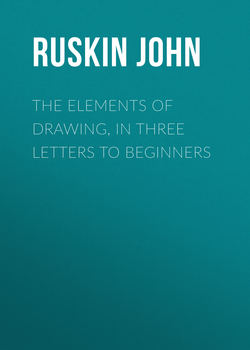Читать книгу The Elements of Drawing, in Three Letters to Beginners - Ruskin John - Страница 9
THE ELEMENTS OF DRAWING
LETTER I.
ON FIRST PRACTICE
EXERCISE V
ОглавлениеFig. 3.
18. When you can manage to tint and gradate tenderly with the pencil point, get a good large alphabet, and try to tint the letters into shape with the pencil point. Do not outline them first, but measure their height and extreme breadth with the compasses, as a b, a c, Fig. 3, and then scratch in their shapes gradually; the letter A, inclosed within the lines, being in what Turner would have called a "state of forwardness." Then, when you are satisfied with the shape of the letter, draw pen-and-ink lines firmly round the tint, as at d, and remove any touches outside the limit, first with the india-rubber, and then with the penknife, so that all may look clear and right. If you rub out any of the pencil inside the outline of the letter, retouch it, closing it up to the inked line. The straight lines of the outline are all to be ruled,7 but the curved lines are to be drawn by the eye and hand; and you will soon find what good practice there is in getting the curved letters, such as Bs, Cs, etc., to stand quite straight, and come into accurate form.
19. All these exercises are very irksome, and they are not to be persisted in alone; neither is it necessary to acquire perfect power in any of them. An entire master of the pencil or brush ought, indeed, to be able to draw any form at once, as Giotto his circle; but such skill as this is only to be expected of the consummate master, having pencil in hand all his life, and all day long,—hence the force of Giotto's proof of his skill; and it is quite possible to draw very beautifully, without attaining even an approximation to such a power; the main point being, not that every line should be precisely what we intend or wish, but that the line which we intended or wished to draw should be right. If we always see rightly and mean rightly, we shall get on, though the hand may stagger a little; but if we mean wrongly, or mean nothing, it does not matter how firm the hand is. Do not therefore torment yourself because you cannot do as well as you would like; but work patiently, sure that every square and letter will give you a certain increase of power; and as soon as you can draw your letters pretty well, here is a more amusing exercise for you.
7
Artists who glance at this book may be surprised at this permission. My chief reason is, that I think it more necessary that the pupil's eye should be trained to accurate perception of the relations of curve and right lines, by having the latter absolutely true, than that he should practice drawing straight lines. But also, I believe, though I am not quite sure of this, that he never ought to be able to draw a straight line. I do not believe a perfectly trained hand ever can draw a line without some curvature in it, or some variety of direction. Prout could draw a straight line, but I do not believe Raphael could, nor Tintoret. A great draughtsman can, as far as I have observed, draw every line but a straight one.
